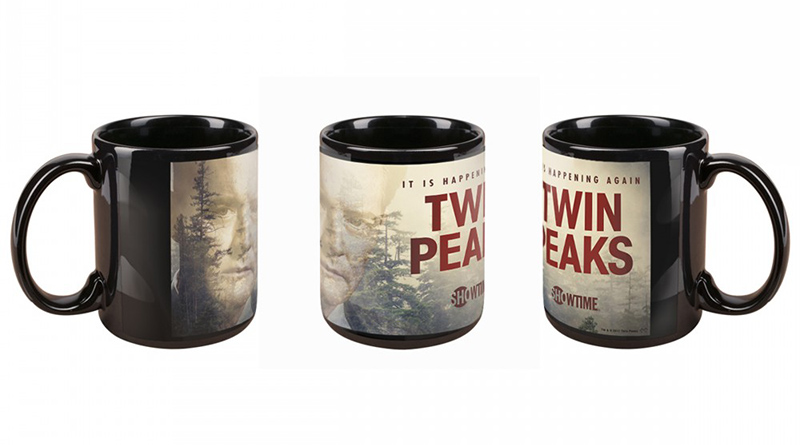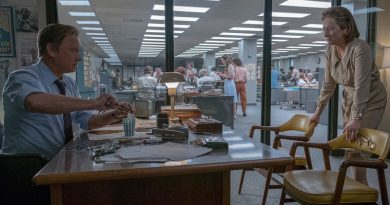What might we expect from the return of ‘Twin Peaks’?
Image credit: Showtime
‘That gum you like is going to come back in style.’ ‘I’ll see you again in 25 years.’ ‘It is happening again’.
To many, these phrases probably mean very little. Strange, enigmatic statements that seem devoid of context. To a knowing minority, however, they have been repeated with increasing frequency over the last few months across various social media platforms in anticipation of the return of the US drama series Twin Peaks (ABC/Lynch-Frost Productions 1990-1). This Sunday, the wait will be over. After 26 years off-screen, the ground-breaking television series co-created by David Lynch and Mark Frost returns for an 18 episode ‘event’ on the CBS-owned premium cable network Showtime. But, for those not in the know, what is Twin Peaks? And what challenges does it face in a much-changed television environment?
At the centre of the original Twin Peaks was the murder of homecoming queen Laura Palmer (Sheryl Lee). This resulted in idiosyncratic FBI Special Agent Dale Cooper (Kyle MacLachlan) being dispatched to investigate the small, seemingly-idyllic Pacific Northwest logging town. However, as Cooper soon found out, beneath the surface both Laura and the titular location were ‘full of secrets’ as surface imagery covered over drug-dealing, prostitution, incest, infidelity and numerous other dubious dealings. Then, as the series, progressed these revelations were combined with supernatural twists where dwarves spoke backwards and danced to jazz music in red-draped rooms, giants stole (and, at the right time, returned) items of jewellery and the owls were not what they seemed. All of this made for a densely-layered, for some immensely frustrating, series that was widely debated online in the early days of the internet and has generated an enduring cult fan base in the years since its cancellation.
Click for video: Cooper’s Dream from ‘Twin Peaks’
I’ve written about Twin Peaks widely before (you can find them here and here) and, in a piece for The Conversation, I outlined that Twin Peaks was very much a product of its time. It was commissioned at the axis of a changing US television industry where, for the first time, the ‘Big 3’ networks (ABC, CBS and NBC) were facing erosions of their audience share due to multiple factors including new distribution platforms like cable, satellite and the VCR. As it was the most-desirable, affluent and educated ‘quality’ audiences that were moving away from linear broadcast television, the networks responded to this problem by commissioning shows that would prioritize the tastes of this niche market whilst not alienating a broader audience. Twin Peaks cannot be divorced from these requirements and, as an experiment, it was ahead of its time.
However, Twin Peaks returns in a very different television landscape – one where the concept of ‘television itself’ is continually being questioned. This is an era of on-demand and non-linear viewing where the ‘watercooler moments’ that Twin Peaks helped to inspire have transferred to social media and discussions can occur in-sync with transmission. This is also an era of anywhere, anytime, streamed ‘content’ rather than Twin Peaks being ‘appointment’ viewing as it was at the time. At the same time, the new series faces a significant question regarding how to address and engage an entirely new audience who may have no knowledge of the original.
One of the biggest challenges that the new series therefore faces concerns its narrative. Lynch and other members of the cast and crew have consistently stressed that the new series will not reboot Twin Peaks for a new audience but instead pick up on the storyline 25 diegetic years later. As I’ve argued elsewhere, these repeated statements from Twin Peaks’s alumni are indicative of retaining the show’s reputation as ‘TV art’ as, rather than being susceptible to the norms of contemporary commercial TV commissioning, the series is an organic whole that has continued off-screen. What this means is that, despite appearing throughout pre-publicity in her homecoming queen guise, Laura Palmer is dead. More pressingly, this narrative strategy also has implications for Cooper given that (spoiler alert!) the character had apparently been possessed by the demon spirit BOB (Frank Silva) following his journey into the nightmarish Black Lodge to save Annie Blackburn (Heather Graham) at the end of series two. Given that this will be Twin Peaks 25 years on, what has happened to Cooper? When will he appear and in what form? Surely he can’t have remained possessed and wandering in the woods asking ‘How’s Annie?’ for the last quarter century, can he?
Click for video: Sequences from the Black Lodge in the final episode of ‘Twin Peaks’.
Addressing this point returns us to the aforementioned question concerning how to make Twin Peaks appeal to a new generation of viewers. Logic established through other reboots would suggest one of two strategies: 1) that there’ll be a crime committed that requires a new, younger FBI agent to be dispatched to the small Pacific-Northwest town so that audiences new and old can orientate themselves through this character’s perspective (see Doctor Who’s ‘Rose’ (2005)), or 2) we’ll start with an established character who’ll quickly recap the key points of the story a la Dana Scully (Gillian Anderson) in last year’s X-Files (Fox/Thirteen-Ten Productions 1992- ) relaunch.
This established industry logic should not be taken for granted when discussing Twin Peaks, though, and there are multiple reasons for this. Firstly, as Rebecca Williams has asserted when studying the series’ fans, Lynch constitutes an ‘ontologically insecure’ auteur as key to his author-brand is doing the exact opposite of conventions. This was well-demonstrated at the glitzy Hollywood launch of the Twin Peaks: The Entire Mystery box set in 2014 where, instead of reflecting on the series’ legacy and those who contributed towards, he instead introduced The Missing Pieces from prequel movie Twin Peaks: Fire Walk With Me (1992) with an enigmatic statement concerning wood.
Click for video: David Lynch talks about wood whilst launching ‘The Entire Mystery’
Secondly, as I regularly say to my undergraduate students when they’ve finished watching an episode of Twin Peaks and felt utterly bamboozled by what they’ve seen, Lynch is a director whose work defies closed meanings and linearity. In fact, as Lynch himself has said in interviews, his oeuvre is much more about creating and exploring moods rather than linear sequences of cause and effect. This was something that the original Twin Peaks frequently excelled in, as the video below of the infamous ‘rock-throwing’ deduction sequence from episode 2 (technically the show’s third episode – I told you it was frustrating) demonstrates. The way that the sequence switches from bizarre whimsy to the implication of darker forces and deeper significance at the change of a musical note was a frequently-repeated device. Don’t be surprised, then, if the first episode provides a range of intense and abstract sequences rather than a jaunty nostalgic trip to the Double R Diner.
Click for video: Cooper’s rock-throwing deductive method – ‘Twin Peaks’
Thirdly, Twin Peaks has its reputation to uphold as innovative, ground-breaking ‘quality’ television. Given the centrality of branding to all areas of the television industry nowadays, this reputation seems doubly important because the show’s ‘quirkiness’ and ability to disarm should constitute some of its core brand values. However, how ground-breaking, shocking or bizarre can Twin Peaks be at present? During the early 90s, Twin Peaks’s uneasiness and imagery were completely out-of-step with anything that US network TV had previously attempted. However, in an era where Six Feet Under (HBO/Actual Size Productions 2001-5) has artfully mediated on the concept of death, where Hannibal (NBC/Living Dead Guy Productions 2013-15) has mutilated and contorted the human body like never before, and when Game of Thrones (HBO/Grok! Television 2011- ) has taken the misogynistic aspects of male-orientated ‘quality’ television off the scale, how can Twin Peaks break the mould?
Click for video: ‘Hannibal’ – pushing the boundaries of TV horror?
The series is going to have to maintain certain aspects of its reputation but it would be devastating to see this reduced to a brand-orientated reading of just being ‘weird’. Lynch’s named attachment to all eighteen episodes has eased these concerns for fans but the question remains as to what television conventions the show will seek to challenge. Ironizing network TV in the way that the original did via soap-within-a-soap Invitation to Love would only work to align it with now-dominant trends in ‘quality’ television nowadays (e.g. Breaking Bad‘s (AMC/Sony Television 2008-13) satirizing of TV through the adverts for Saul Goodman’s (Bob Odenkirk) legal firm). Will it have to be a case of, to paraphrase HBO’s famous anti-network TV slogan, ‘It’s not HBO. It’s Twin Peaks’? Only time will tell.
I’d like to end this blog by reflecting on the marketing strategies that Showtime has used as these reaffirm much of what I’ve said here. Official publicity paratexts have either played on the familiarity of characters such as Cooper and Laura Palmer (e.g. press adverts), replayed the sense that Twin Peaks’s narrative world features an uncanny juxtaposition between the known and the unknown (e.g. the teaser released just before Christmas 2016 which saw Agent Hawk (Michael Horse) discuss the town, only to be suddenly interrupted by bizarre imagery) or just gone for straight ironizing of marketing techniques by releasing a video of Lynch’s Gordon Cole character eating a doughnut. We’ve seen nothing of Amanda Seyfried, Michael Cera or Naomi Watts and so don’t know if they’ll be cameos or something else. In short, this publicity has given nothing away. That, in itself, is very Twin Peaks.
Enjoy Sunday, friends!
Click for video: Showtime promo – David Lynch eats a doughnut.


